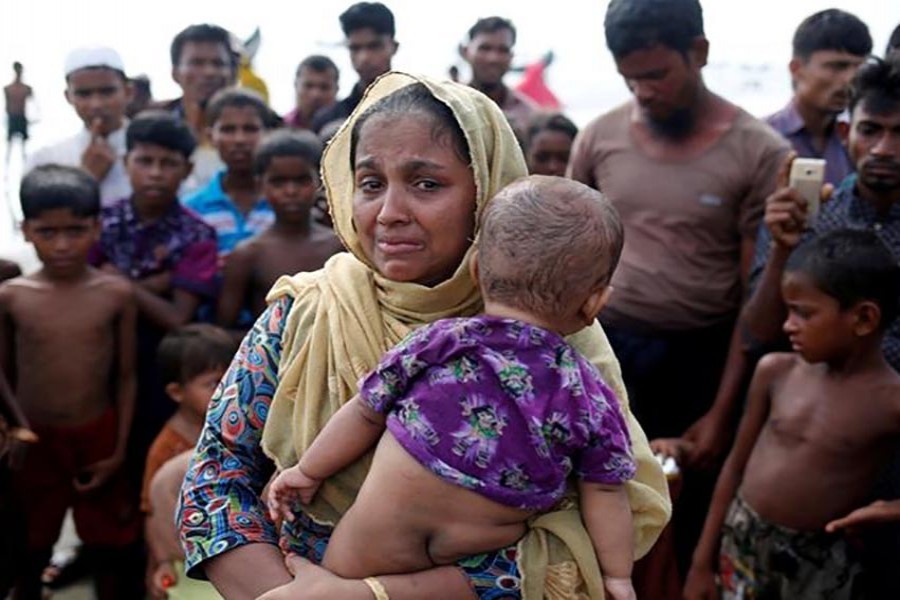An early repatriation of Rohingya refugees to Myanmar appears to be a distant hope despite signing of an agreement between the governments of Bangladesh and Myanmar. The realities on the ground are getting harsh for the hosts. Recently this writer made a whirlwind trip to Cox's Bazar to get the views of refugees, government servants and ordinary people, especially from the host communities.
Since August 25, 2017, some 6,50,000 refugees have taken shelter in Bangladesh to save their lives and dignity. Taking the earlier arrivals into account, a total of one million refugees now live in only two upazilas - Teknaf and Ukhia - where the population in the host communities is outnumbered by a few folds. Responding to the call of humanity, the Bangladesh government has sheltered the persecuted and distressed Rohingyas. Shelters apart, provisions for pure drinking water, sanitary latrines, health facilities and protection centres all went apparently well although initial setbacks were there. The United Nations High Commissioner for Refugees (UNHCR), the International Organisation for Migration (IOM), the World Food Programme (WFP) and the World Health Organisation (WHO) are all in the field with humanitarian assistance. Besides these international bodies, non-governmental organisations, including the Bangladesh Rural Advancement Committee (BRAC), have been working to help the distressed humanity.
One million refugees are now living in 650 square km. At the initial stage, the host community extended all their support on humanitarian grounds but growingly they have become irritant in the face of severe socio-economic problems the guests have created. When the influx started in August last year, standing crops were damaged as refugees walked through the fields. A guesstimate shows that 30-40 per cent of the standing crops, especially betel leaf gardens, were severely damaged. At the beginning, shelters of refugees in schools led to stoppage of teaching because of furniture damaged or lost. Many educational institutions are now being used as spaces for Rohingya refugee management. Schoolchildren got scared at the arrival of new faces and the enrolment rate has just halved. Huge traffic due to provision of services to refugees by different organisations has made already bad roads the worst ones. Construction of a few thousands of deep tube wells for a few hundred thousands of Rohingyas took the water table down, thus making water costlier than before.
It is quite obvious that excess demand of essentials, induced by the refugee influx, increased the prices of commodities by a big margin thus imposing an unintended tax on the host communities. The rise in house rents benefited owners at the cost of tenants. The most important adverse effect came from the entry of cheap Rohingya labour in the local market. The daily wage has reportedly come down from Tk 400 to Tk 150. The fact that the government and the national and international non-governmental organisations (NGOs) have taken much care of the refugees but very little for the host communities has sparked a sense of frustration among the locals as growingly Rohingyas are becoming competitors to them.
Illegal markets for drugs and arms, already in existence in these parts of Bangladesh, have flourished further with the influx of the Rohingya refugees. Massive deforestation will create a host of problems. A WFP survey shows that firewood is the main cooking fuel and 60 per cent of new and host communities depend on its collection locally.
The WFP survey on Rohingya Emergency Vulnerability Assessment shows about 60 per cent of the total refugee population are highly vulnerable and one-fourth of them vulnerable. This compares with 13 per cent and 26 per cent respectively of host communities. More than 80 per cent of new arrivals from Myanmar would not be able to meet their food requirements without provision of assistance. The WFP survey also shows that half of all arrivals could bring nothing. Thirty seven per cent could bring money, 21 per cent jewelry and 6.0 per cent electric devices.
Four-fifths of refugees in current locations at the moment face cash constraint followed by 45 per cent getting insufficient food. Data suggest that access to nutrition depends, among others, on the modalities of assistance to the refugees.
Roughly two-thirds of the Rohingyas reported that they would return soon provided conditionalities are met as to citizenship, compensation for lost assets, security, etc. Only about 4.0 per cent are willing to return home as early as possible. By and large, about 60 per cent of the refugees expressed satisfaction over the current living conditions in the refugee camps which are much more improved than those in 1992 or 2016. Three-fourths reported that they hoped camp conditions would improve following more relief and improvement in availability of basic facilities.
But the local communities fear that the Rohingya refugees are not returning to Myanmar very soon. The people of Cox's Bazar might have to pay a heavy price for hosting the refugees in terms of livelihood, environment, social fabric and deteriorating law and order in the days ahead.
The writer is a former
Professor of Economics at
Jahangirnagar University.


